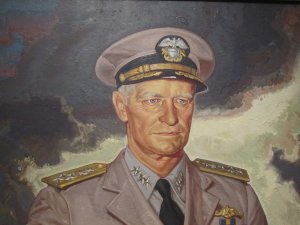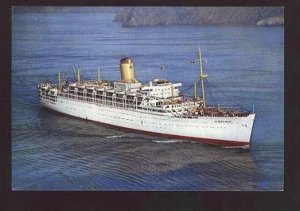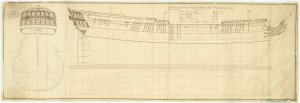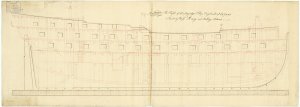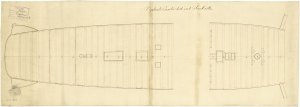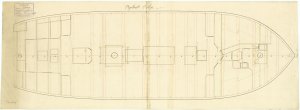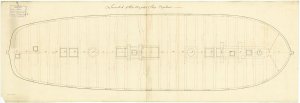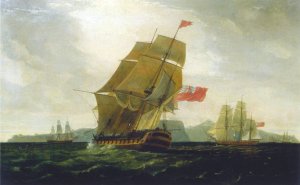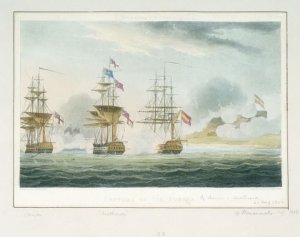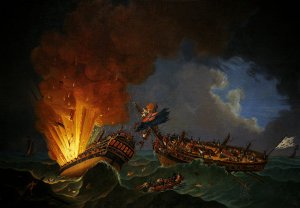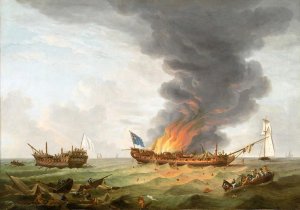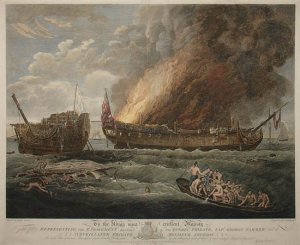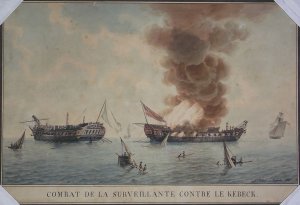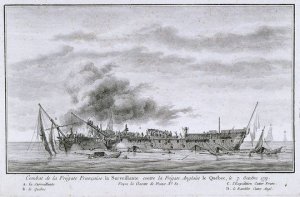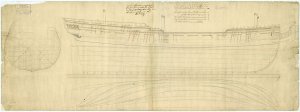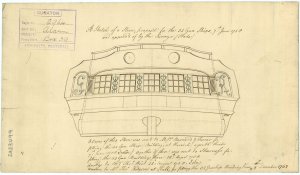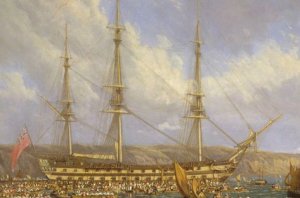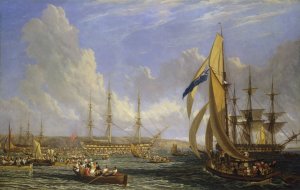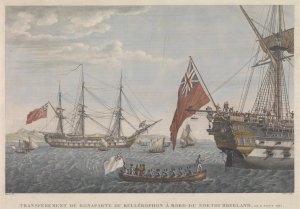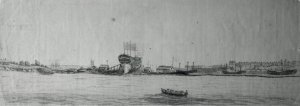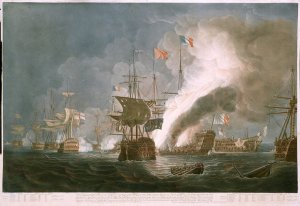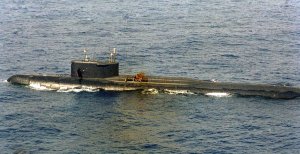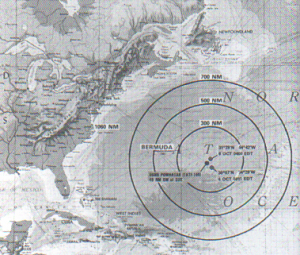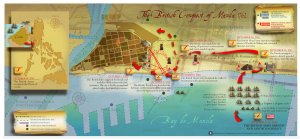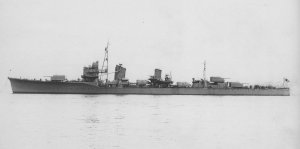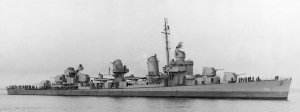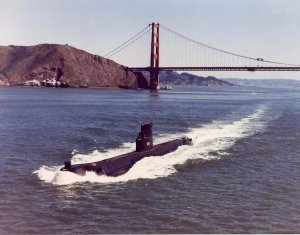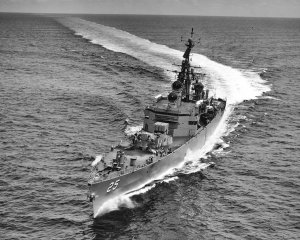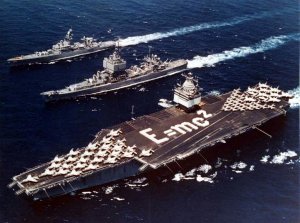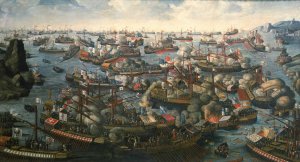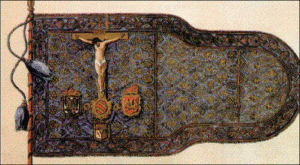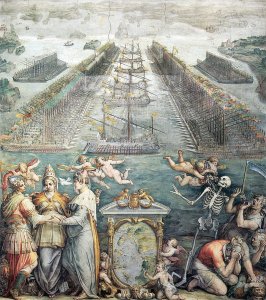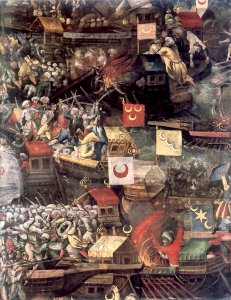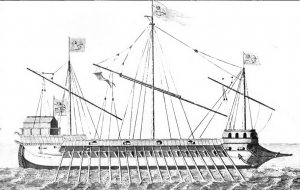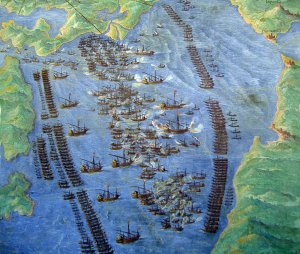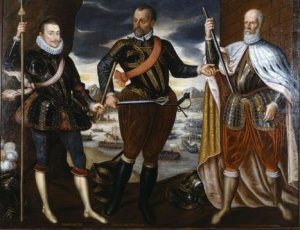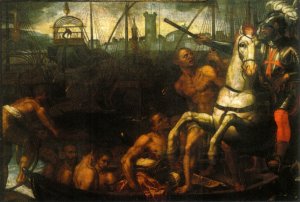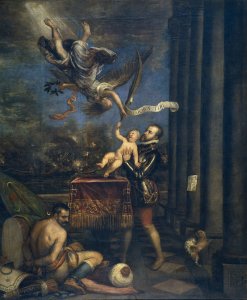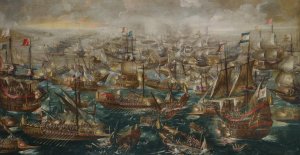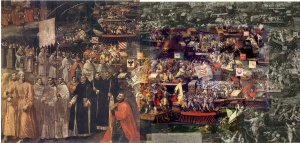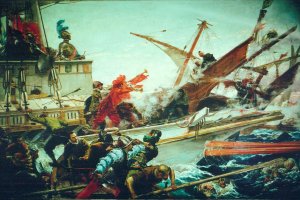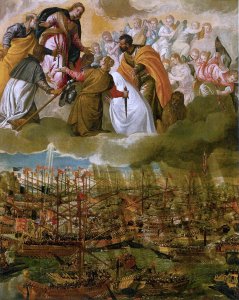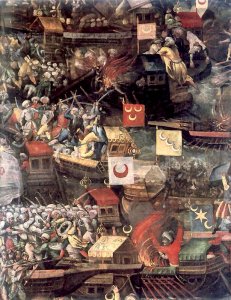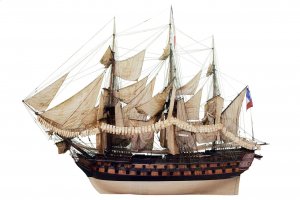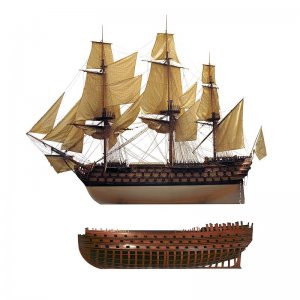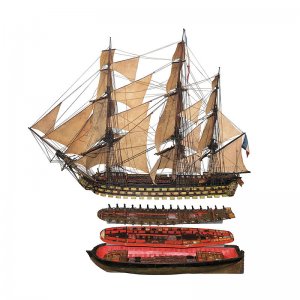Today in Naval History - Naval / Maritime Events in History
7 October 1795 - Battle of the Levant Convoy / Action of 7 October 1795
The Battle of the Levant Convoy was a naval engagement of the
French Revolutionary Wars fought on 7 October 1795. During the battle, a powerful French squadron surprised a valuable British
convoy from the
Levant off
Cape St Vincent on the coast of
Portugal. The convoy was weakly defended, and although the small escort squadron tried to drive the French back, they were outmatched. In the ensuing action one of the British
ships of the line and almost the entire convoy was overrun and captured. The French commander, Commodore
Joseph de Richery, then retired to the neutral Spanish port of
Cádiz, where he came under
blockade.
The annual British Levant convoy was a mercantile operation in which valuable merchant shipping from ports across the
Eastern Mediterranean gathered together for security under escort to Britain by
Royal Navy warships. In 1795, this escort comprised three ships of the line, one in a poor state of repair, and several frigates under the command of Commodore
Thomas Taylor. Taylor split the convoy, sailing in two separate divisions. On 7 October a French squadron under Richery, sent from
Toulon to attack the
Newfoundland fisheries, encountered Taylor's division of the convoy.
Taylor attempted to hold off Richery for long enough for the merchant ships to scatter and escape, but one of his ships,
HMS Censeur lost a top-mast as he formed a line of battle and was rapidly overwhelmed by the French. With his line broken and
frigates seizing the merchant ships unopposed, Taylor turned away from the battle and withdrew, leaving the convoy to its fate. Only one ship survived. Richery took his prizes to Cádiz in Southern Spain, where he was subject to a blockade by a British squadron under Rear-Admiral
Robert Mann. Nearly a year later he escaped with the help of the Spanish to inflict
severe damage on the fishing fleets off
Maritime Canada.
Background
Main article:
Richery's expedition
The French Navy in the Atlantic had suffered severe losses in a series of defeats during the early years of the French Revolutionary Wars, particularly at the
Glorious First of June in 1794 and during the
Croisière du Grand Hiver the following winter. In June 1795 three more ships were lost in the defeat at the
Battle of Groix. Requests for reinforcements were sent to the Mediterranean Fleet, which had suffered its own severe losses at the
Siege of Toulon in 1793, and later at the
Battle of Genoa and the Battle of the Hyères Islands in the spring and summer of 1795. The commander of the Mediterranean Fleet, Vice-amiral
Pierre Martin acceded to the request, preparing a squadron of six
ships of the line and three
frigates under Contre-amiral Joseph de Richery to reinforce the
Brest fleet.
This force was under orders to sail across the Atlantic, unite with French naval units in the Caribbean to land an army in
Saint-Domingue and attack shipping at
Jamaica. It was then to sail north to attack the important
cod fisheries off Newfoundland and Maritime Canada, before returning to France via the
Azores to unite with the fleet at Brest. Martin was wary of the British Mediterranean Fleet, which had so recently inflicted defeats on his own force, but the British commander Admiral
William Hotham had kept the blockade of Toulon loose, based at his anchorage at
San Fiorenzo, and Richery was able to escape into the
Ligurian Sea without being observed on 14 September. Martin also knew that the annual British merchant
convoy from the
Levant was due to pass westwards on its way to the
Straits of Gibraltar, and several weeks later sent out
a second squadron, under Commodore
Honoré Ganteaume, in search of it.
Martin was unaware that the convoy had sailed earlier than anticipated, reaching
Gibraltar ahead of Richery and long before Ganteaume even sailed. At Gibraltar the 63-ship convoy met with its escort provided from Hotham's fleet. This force was led by Commodore Thomas Taylor in 74-gun HMS
Fortitude, accompanied by HMS
Bedford and HMS
Censeur as well as the frigates HMS
Argo, HMS
Juno, HMS
Lutine and the fireship HMS
Tisiphone.
Censeur, under the command of Captain
John Gore, was not fit for service; the ship had been a French warship captured off
Genoa in March and was still in a poor state of repair, armed
en flute and carrying only jury masts.
(Jury rigging is both a noun and a verb describing makeshift repairs made with only the tools and materials at hand. Its origin lies in such efforts done on boats and ships, characteristically sail powered to begin with. After a dismasting, a replacement mast and if necessary yard would be fashioned and stayed to allow a craft to resume making way.)
Richery's encounter
Taylor's convoy sailed from Gibraltar on 25 September, progressing slowly westwards into the Atlantic. The following day Taylor split his force, sending 32 merchant ships with
Argo and
Juno, while he took 31 merchant ships along the Spanish and Portuguese coasts with his main force. By the morning of 7 October the convoy was passing slowly around
Cape St Vincent, 144 nautical miles (267 km) offshore with land to the southeast. At 09:30 sails were sighted to the northeast and Thomas rapidly realised that they were an enemy force. Issuing hasty orders to his squadron to establish a short line of battle, he formed up with
Fortitude in the lead, followed by
Bedford and
Censeur, supported by
Lutine and
Tisiphone. The convoy was ordered to scatter.
Richery bore down on Taylor's small squadron, sending his frigates
Embuscade,
Félicité and
Friponne to attack the fleeing merchant ships.
[8] Taylor hoped to hold the French off for long enough to allow the convoy to escape, but the frigates simply evaded the line. In addition, the damaged
Censeur was unable to hold station and at 13:00 the jury top-foremast collapsed over the side forcing Gore to fall back, away from Taylor's other ships. Taylor discussed the situation with his officers and Captain Augustus Montgomery on
Bedford, reaching agreement to withdraw.
Fortitude and
Bedford then pulled away from the French in formation, leaving
Censeur behind.
At 13:50 the leading French ships opened fire on
Censeur, Gore returning fire, distantly assisted by the stern-chaser guns on
Fortitude and
Bedford, Taylor and Montgomery having their gunners smash holes in their ships' sterns to fit the cannon. Richery's squadron bore down on the retreating British line, firing at the masts on
Censeur and bringing down both remaining topmasts in quick succession. Gore had not been expected to engage in action in his damaged ship and so there was little gunpowder on board. By 14:30 it had all been consumed and, abandoned by Taylor, Gore
struck his colours and surrendered to three of the French ships. Richery's leading ships now engaged
Lutine, Captain William Haggitt briefly returning fire as he pulled away. With
Censeur secured and his frigates amid the merchant ships, Richery called off pursuit and allowed Taylor to retreat.
Aftermath
Unprotected, the Levant convoy was destroyed. Richery's frigates captured all but one of the British merchant vessels, 30 ships. Gathering his prizes, the French admiral turned back towards the Spanish coast, eventually anchoring in the neutral but friendly Spanish fleet base of
Cádiz. Due to treaties in place at the time, only three of Richery's ships could dock at Cádiz itself, the rest anchoring in the less sheltered port of
Rota. There he was trapped; Hotham had learned on 22 September that Richery was at sea, and on 5 October had dispatched a squadron of six ships of the line and two frigates in pursuit under Rear-Admiral
Robert Mann. As Richery had a three week start, Mann arrived off Cádiz far too late to intercede in the action, but did find Richery only recently anchored in the harbour.
[10] Following his orders to pursue the French, Mann established a blockade of Cádiz awaiting Richery's return to sea. The
Argo convoy, under Captain
Richard Burgess proceeded unchallenged and reached Britain intact. Historian
William Laird Clowes laid blame for the destruction of the convoy on Hotham, stating that his behaviour "offers additional proof of that officer's unfitness for the very important command with which he had been entrusted." This was not the first time the Levant convoy had been targeted by the French Navy; 102 years earlier during the
Nine Years' War a much larger Levant convoy had been overrun and destroyed by the French in the same waters, at the
Battle of Lagos.
The blockade was to last ten months, during which Richery was unable to find an opportunity to escape Mann's watch on the approaches to the Spanish port. His ships were battered by winter storms, and on 17 December
Victoire,
Duquesne and
Révolution were all blown on shore and badly damaged. They required extensive repairs in the Cádiz dockyards before they were ready for sea once more. The French were eventually released by diplomatic means; in the spring of 1796 the French Republic and the Kingdom of Spain had begun negotiations on an alliance against Britain, which was eventually signed at the
Treaty of San Ildefonso on 19 August. As a gesture of good will, the Spanish fleet at Cádiz under Admiral Juan de Lángara agreed to escort Richery out of the harbour with sufficient force to dissuade an attack by Mann. Lángara took 20 ships of the line and 14 other vessels to sea on 4 August, accompanied by Richery's ten warships. They found the approaches to Cádiz empty; Mann had retired from the blockade on 29 July under orders from Vice-Admiral
Sir John Jervis.
Lángara sent Richery 300 nautical miles (560 km) westwards with a large escort under Rear-Admiral José Solano y Bote, the French admiral then separating and fulfilling his original mission to attack the fisheries of Maritime Canada. During September he burned fishing fleets and coastal communities across Newfoundland and
Labrador before returning to France unimpeded, having captured or destroyed more than a hundred British merchant ships during his operation.
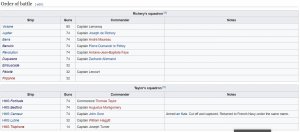 Censeur
Censeur was a 74-gun
Pégase-class ship of the line of the French Navy, launched in 1782. She served during the last months of the American War of Independence, and survived to see action in the French Revolutionary Wars. She was briefly captured by the British, but was retaken after a few months and taken back into French service as
Révolution. She served until 1799, when she was transferred to the Spanish Navy, but was found to be rotten and was broken up.
HMS Fortitude was a 74-gun third-rate ship of the line of the Royal Navy, built by John Randall & Co. and launched on 23 March 1780 at Rotherhithe.

Battle of Dogger Bank
Under Captain
Richard Bickerton,
Fortitude served in the
English Channel. In April 1781 she participated in the
second relief of
Gibraltar. In May 1781, during the Fourth Anglo–Dutch War, Vice-Admiral Hyde Parker's shifted his flag from HMS
Victory to
Fortitude. On 5 August,
Fortitude fought in the Battle of Dogger Bank as Parker's flagship. After a desperate, bloody battle in which neither combatant gained any advantage, both sides drew off.
HMS Bedford was a Royal Navy 74-gun third rate of the Royal Oak.class. This ship of the line was launched on 27 October 1775 at Woolwich.
HMS Argo was a 44-gun fifth-rate
Roebuck-class ship of the Royal Navy. She was launched in 1781 from Howdon Dock. The French captured her in 1783, but 36 hours later the British recaptured her. She then distinguished herself in the French Revolutionary Wars by capturing several prizes, though she did not participate in any major actions. She also served in the Napoleonic Wars. She was sold in 1816.
HMS Juno was a Royal Navy 32-gun
Amazon-class fifth rate. This frigate served during the American War of Independence, and the French Revolutionary and Napoleonic Wars.
Lutine was a frigate which served in both the French Navy and the Royal Navy. She was launched by the French in 1779. The ship passed to British control in 1793 and was taken into service as
HMS Lutine. She sank among the West Frisian Islands during a storm in 1799.
She was built as a French
Magicienne-class
frigate with 32 guns, and was launched at Toulon in 1779. During the French Revolution,
Lutine came under French Royalist control. On 18 December 1793, she was one of sixteen ships handed over to a British fleet at the end of the Siege of Toulon, to prevent her being captured by the French Republicans. In 1795, she was rebuilt by the British as a
fifth-rate frigate with 38 guns. She served thereafter in the
North Sea, where she was part of the blockade of Amsterdam.
Lutine sank during a storm at Vlieland in the West Frisian Islands on 9 October 1799, whilst carrying a large shipment of gold. Shifting
sandbanks disrupted salvage attempts, and the majority of the cargo has never been recovered. Lloyd's of London has preserved her salvaged bell – the
Lutine Bell – which is now used for ceremonial purposes at
their headquarters in London.
https://en.wikipedia.org/wiki/Battle_of_the_Levant_Convoy
https://en.wikipedia.org/wiki/HMS_Fortitude_(1780)
https://en.wikipedia.org/wiki/HMS_Bedford_(1775)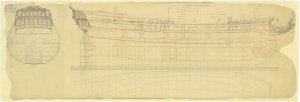


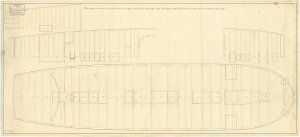
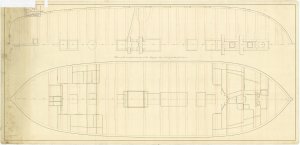
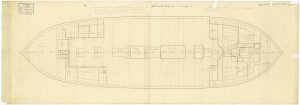
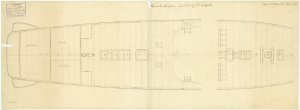
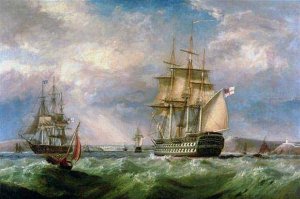
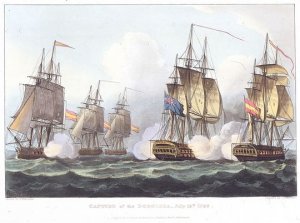












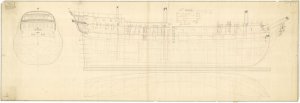

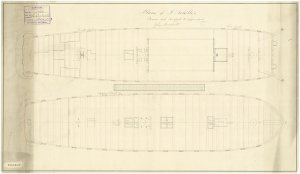
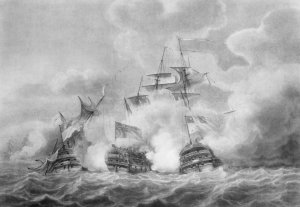
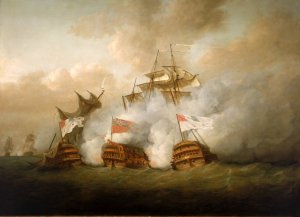

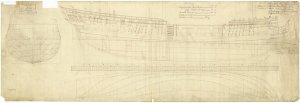


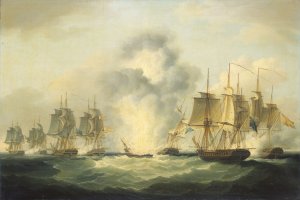
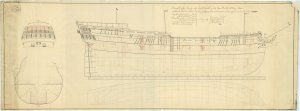
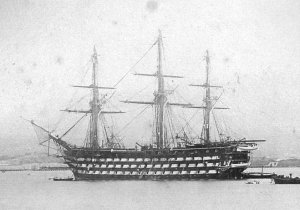
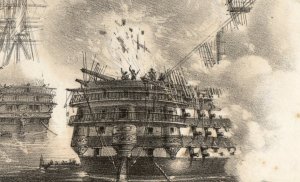
 of a Russian shell on Ville de Paris.
of a Russian shell on Ville de Paris.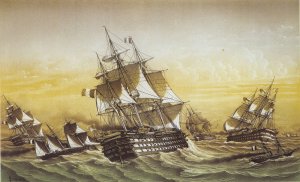
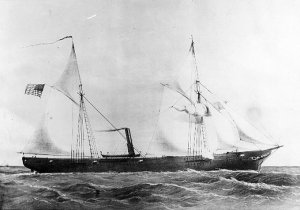
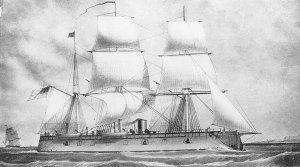

 for the third award of the Navy Distinguished Service Medal by President Harry S. Truman "for exceptionally meritorious service as Commander in Chief, U.S. Pacific Fleet and Pacific Ocean Areas, from June 1944 to August 1945."
for the third award of the Navy Distinguished Service Medal by President Harry S. Truman "for exceptionally meritorious service as Commander in Chief, U.S. Pacific Fleet and Pacific Ocean Areas, from June 1944 to August 1945."